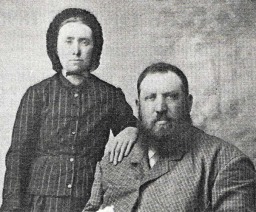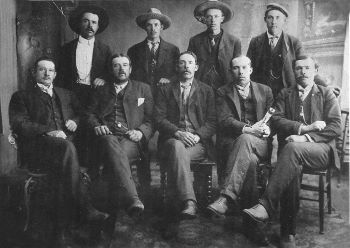The Search for the Ancestors of Johann Fast (1852-1920)
The Search for the Ancestors of Johann Fast (1852-1920)
Copyright 2022 by Barry Teichroeb. All Rights Reserved.
My great-great-grandfather, Johann Fast, was born in 1852 in one of the Mennonite Villages in present day Ukraine. The family lived in Rosenthal, Chortitza Colony before emigrating to Canada in 1892. This much was clear from passenger lists and village maps. The story of the family’s pioneering activities and the lives of Johann’s descendants was well documented. His ancestry was unknown.

Johann Fast and his wife Maria Krahn
Years ago, my great-uncle, Ben Fast, assembled the Fast family tree based on family records, recollections, and any genealogical source documents he could find. In the 1960s and 1970s research was considerably more difficult than it is today but he made the best of the resources at hand and published his results. It was a good foundation.
A decade or so later I picked up his work and began my own research to build on the foundation he had laid. I had no hint, when I started, that this would become a thirty-year mission.
I worked my way through the journals, books and other materials that were available to find clues about Johann’s parents, without any success. The internet gradually exposed a richer resource base but still I found nothing to help me.
At one point I reached out to Ben for any details he might recall. He wrote to say that his grandfather, Johann, had two brothers, Heinrich, who was a life-long bachelor, and Jacob, whose son, also Jacob, lived near Winnipeg for a while. Ben had visited the younger Jacob in Winnipeg once in the distant past. That was all he knew.
I tried to use these names to triangulate any kind of relationship to a family, a location, or a census entry, without success. I searched Canadian census records for these two brothers and came up with nothing. Over the ensuing years I repeated these efforts whenever I found a new set of genealogical records, but nothing emerged. I obtained Johann’s death certificate and learned that his father was listed as Johann Fast, but this new information was not very helpful at all.
Very recently I came across a picture of Johann’s sons, a reproduction from my mother’s collection of old family photographs (she is the great-granddaughter of Johann (1852)). Taken in Rosthern, Saskatchewan, the picture was well over a hundred years old, and it looked like a photo from the wild west. I found it curious that there were nine men in the picture, because Johann had eight sons. I asked my mother what she knew about the photo. She had the original, with names written on the back. I learned that the ninth person in the photo was Heinrich Fast, the uncle of the eight brothers. He appeared to be about the same age as the others and anyone would assume he was another brother. In fact, born in 1871, he was only a year older than the eldest of Johann’s sons, and 19 years younger than Johann.

Heinrich Fast on the far left, with Johann’s eight sons
This was a turning point in my research. It placed Heinrich in Rosthern, at least long enough for a photo shoot, and gave me hope. Using “Find a Grave” (www.findagrave.com) I found his date of death. With that information I tracked down his Obituary, published in the old German language newspaper Der Bote. The obituary confirmed he was never married and that he had come to Canada in 1904 and settled in Rosthern. I now had enough information to obtain a death certificate.
Heinrich’s death certificate contained the names of his parents, Johann Fast and Judith Rempel. Johann (1832) and Judith (1832) were in the Grandma Mennonite genealogical database. A considerable amount of genealogical work had been recorded, establishing three or four generations of their ancestry going back to the Polish-Lithuanian Commonwealth where so many Dutch Mennonites lived for two centuries. In the database Johann (1832) and Judith (1832) were not associated with sons Johann (1852) and Heinrich (1871), but their other son, Jacob, was connected to them. After completing further research, I learned the reason for the missing associations and the fascinating story of Jacob and his family.
Johann’s Ancestry
Johann’s mother was Judith Rempel (1832). She was born to Dietrich Rempel (1792) and Maria Nickel (1792) in the village of Chortitza in the Mennonite settlement of Chortitza. Judith’s grandfather, also a Dietrich Rempel, had been an early settler of the Chortitza Colony, homesteading initially in the village of Einlage in 1789 with his first wife. The Rempels had emigrated from the Konigsberg area of Prussia. When his wife died soon after they arrived in the colony, grandfather Dietrich married Helena Wiebe. Helena and her parents also were among the earliest settlers, having arrived in 1789 and established a homestead in Einlage. The Wiebes had emigrated from Stobbendorf, a town about 40 kilometers east of Danzig. Judith’s father, Dietrich, was born to Helena Wiebe and Dietrich Rempel in early autumn 1792.
Less is known about Judith’s mother, Maria Nickel (1792). Born on 25 December 1792, she probably was a daughter of Johann Nickel (1746) and Anna Nickel (1749) who emigrated in 1797 from Tryl, a town 80 kilometers south of Danzig on the west bank of the Vistula River. There is no indication Johann and Anna were closely related even though they had the same surname.
Johann’s father was Johann Fast (1832). He was born to Johann Fast (1800) and Aganetha Toews (1803). The elder Johann Fast (1800) emigrated around 1821 from Wernersdorf, a village on the Nogat River, a few kilometers south of modern day Malbork. Poland. His parents were Cornelius Fast (1765) and Maria Toews (1764). They also emigrated in 1821 and settled in the Molotschna colony.
Aganetha Toews (1803) came to Russia as an infant in 1804 with her parents Jacob Toews (1768) and Aganetha Epp (1782). The Toews family emigrated from Sandhof, a village near Malbork. Her father, Jacob Toews (1768), was a brother of Maria Toews (1764) and consequently Johann Fast (1800) and his wife Aganetha Toews (1803) were cousins.
Johann’s Brother Jacob
Johann’s brother, Jacob, was born in 1860. Unlike his brothers, Jacob (1860) did not emigrate to North America. He stayed in Russia, surviving the Russian Revolution, the Ukrainian War of Independence, and the First World War. Life was very difficult in the Ukraine after years of armed conflict and political upheaval. Jacob (1860) had three sons with his wife, Gertruda Dyck (there could be a fourth son, but the data is unclear). According to details in the Grandma database two of the sons were taken by the secret police of the Stalinist regime in the 1930s. They were never seen again. The third son, Jacob (1910), survived.
World War II brought more upheaval. In 1941 the German armies invaded Russia, in some places occupying territory in Ukraine that had been inhabited by Mennonites for 150 years. The occupying forces established a Ukrainian Auxiliary Police Force to implement Nazi policy and conscripted local men to fill the ranks. German-speaking natives were preferred, and many Mennonite men found themselves collaborating with the Nazi regime, Jacob (1910) among them. Some of the activities performed by the auxiliary forces were administrative, overseeing the governance of occupied villages and cities. However, some of the work was of a more sinister nature and, particularly in major population centers, involved identifying and reporting Jews to the German army and administering the distribution of property taken from murdered Jews.
In 1943 the German forces left Russia, retreating westward accompanied by hundreds of thousands of German-speaking inhabitants, part of a Nazi policy to repatriate German speaking people dispersed across Europe. Among them were thousands of Mennonites. These people were resettled in German-controlled territories and processed to become German citizens. Jacob (1910) and his family were swept into this mass exodus from Ukraine. Jacob’s parents were with them. In time they became German citizens. The family lineage connecting Johann (1832) to his son Jacob (1860) and his grandson Jacob (1910) was diligently recorded in German archives. In 1947 Jacob (1910) and his family, along with his now widowed mother, immigrated to Canada.
Jacob (1910) moved with his family to Steinbach, Manitoba, just outside Winnipeg. He had a daughter there in 1948. In 1954 Jacob became a Canadian citizen.
The family relocated to Ontario at some point. Years later, on 12 November 2001 this headline appeared in the Toronto Star: “War crime case proceeds against ill 91-year-old”.
The article was about Jacob Fast (1910), whose wartime past had been discovered. Government officials had learned about his participation in the Ukraine Auxiliary Police Force and his German citizenship. He had not disclosed these facts when he applied for citizenship in Canada. The courts found no evidence that Jacob had committed any war crimes but because he was deemed to be a collaborator with the German occupying forces, he was ineligible for Canadian citizenship, and it was revoked in May 2007. By now Jacob was elderly and very ill. He died in Canada a few weeks later.
Sources
CBC News, 24 May 2007 (www.cbc.ca/news/canada/ontario-men-lose-citizenship-for-lying-about-alleged-nazi-pasts-1.681467).
Der Bote Obituaries, 3 February 1937 (Rosthern, 3 February 1937).
Fast, Bernhard H., Fast-Epp Genealogy (Saskatoon, Ben Fast, 1978).
Fast, Bernhard H., From Windmills to Prairies (Saskatoon, Ben Fast, 1991).
Find A Grave (www.findagrave.com).
Genealogical Registry and Database of Mennonite Ancestry (California Mennonite Historical Society, www.grandmaonline.org).
Penner, Glenn H., The First Mennonite Settlers in the Chortitza Settlement (Winnipeg, Manitoba Mennonite Historical Society, www.mmhs.org).
Rempel, Marlene, “Dietrich Rempel 1792” (Winnipeg, Mennonite Heritage Archives, Series 1 Unpublished Genealogies, Volume 5232 Mennonite Genealogy Inc. #55).
Rempel, Peter, Mennonite Migration to Russia, 1788-1828 (Winnipeg, Manitoba Mennonite Historical Society, 2000).
Rempel, Tina, “Isbrand Rempel 1737” (Winnipeg. Mennonite Heritage Archives. Series 1 Unpublished Genealogies, Volume 5232 Mennonite Genealogy Inc. #56).
Schapansky, Henry, The Mennonite Migrations (and The Old Colony) (Rosenort MB, Henry Schapansky, 2006).
Steiner, Sam, Ontario Mennonites and Criminal Behavior (In Search of Promised Lands, https://ontariomennonitehistory.org/tag/jacob-fast/).
Stumpp, Karl, The Emigration from Germany To Russia in the Years 1763 – 1862 (Lincoln, Nebraska, American Historical Society of Germans from Russia, 1973).
Teichroeb, Barry, Fast-Teichroeb Genealogy (www.mooserungenealogy.com).
Thiessen, Richard, Index of Einwandererzentralstelle (EWZ) Collection (Waterloo, Mennonite Archives of Ontario, Conrad Grebel University College. https://uwaterloo.ca/mennonite-archives-ontario/discrete-single-items/microfilm-collections/einwandererzentralstelle-ewz-collection).
Unruh, B. H., Die niederlandisch - niederdeutschen Hintergrunde der mennonitischen Ostwanderungen in 16, 18 und 19 Jahrhundert (Karlsruhe, Germany, Heinrich Schneider, 1955).
In addition, information was drawn from numerous census records for Prussia and the Mennonite Settlements in Russia published online by the Manitoba Mennonite Historical Society (Winnipeg, Manitoba Mennonite Historical Society, www.mmhs.org).
Post a comment